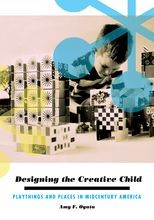Designing the Creative Child: Playthings and Places in Midcentury America
Designing the Creative Child: Playthings and Places in Midcentury America
Cite
Abstract
This book explores how a perception of children as imaginative and “naturally” creative was constructed, disseminated, and consumed in the United States after World War II. I argue that educational toys, playgrounds, the smaller middle-class house, thousands of postwar schools, and children’s museums, were designed to cultivate an ideal of imagination in a growing cohort of Baby Boom children. Psychologists avidly studied creativity after 1950, and their research was embraced by the educational toy industry, invoked in parenting guides, taught in school arts classes, and erected in new school buildings and museums. Enthusiasm for encouraging creativity in children met and countered Cold War fears of failing competitiveness and the postwar critique of social conformity, becoming an emblem of national revitalization. I describe how a belief in children’s capacity for imagination and independent thinking was transformed from an elite concern of the interwar years to a fully consumable and aspirational ideal that has not yet abated. I emphasize the ways that material goods and spaces embodied this abstract social and educational discourse. However, I also argue that things and spaces were not passive receptacles, but material actors that actively transformed a popular understanding of creativity during a crucial period of educational reform, economic expansion, and Cold War anxiety. Historicizing, rather than essentializing, the idea of childhood creativity, reveals how this notion continues to haunt everyday things, the built environment, and American culture.
Sign in
Personal account
- Sign in with email/username & password
- Get email alerts
- Save searches
- Purchase content
- Activate your purchase/trial code
Institutional access
-
Sign in through your institution
- Sign in with a library card Sign in with username/password Recommend to your librarian
Institutional account management
Sign in as administratorPurchase
Our books are available by subscription or purchase to libraries and institutions.
Purchasing information| Month: | Total Views: |
|---|---|
| October 2022 | 2 |
| October 2022 | 2 |
| November 2022 | 1 |
| March 2023 | 2 |
| March 2023 | 1 |
| May 2023 | 3 |
| June 2023 | 2 |
| July 2023 | 1 |
| July 2023 | 1 |
| July 2023 | 1 |
| August 2023 | 1 |
| September 2023 | 3 |
| September 2023 | 2 |
| November 2023 | 2 |
| November 2023 | 1 |
| January 2024 | 2 |
| April 2024 | 2 |



Get help with access
Institutional access
Access to content on Oxford Academic is often provided through institutional subscriptions and purchases. If you are a member of an institution with an active account, you may be able to access content in one of the following ways:
IP based access
Typically, access is provided across an institutional network to a range of IP addresses. This authentication occurs automatically, and it is not possible to sign out of an IP authenticated account.
Sign in through your institution
Choose this option to get remote access when outside your institution. Shibboleth/Open Athens technology is used to provide single sign-on between your institution’s website and Oxford Academic.
If your institution is not listed or you cannot sign in to your institution’s website, please contact your librarian or administrator.
Sign in with a library card
Enter your library card number to sign in. If you cannot sign in, please contact your librarian.
Society Members
Society member access to a journal is achieved in one of the following ways:
Sign in through society site
Many societies offer single sign-on between the society website and Oxford Academic. If you see ‘Sign in through society site’ in the sign in pane within a journal:
If you do not have a society account or have forgotten your username or password, please contact your society.
Sign in using a personal account
Some societies use Oxford Academic personal accounts to provide access to their members. See below.
Personal account
A personal account can be used to get email alerts, save searches, purchase content, and activate subscriptions.
Some societies use Oxford Academic personal accounts to provide access to their members.
Viewing your signed in accounts
Click the account icon in the top right to:
Signed in but can't access content
Oxford Academic is home to a wide variety of products. The institutional subscription may not cover the content that you are trying to access. If you believe you should have access to that content, please contact your librarian.
Institutional account management
For librarians and administrators, your personal account also provides access to institutional account management. Here you will find options to view and activate subscriptions, manage institutional settings and access options, access usage statistics, and more.